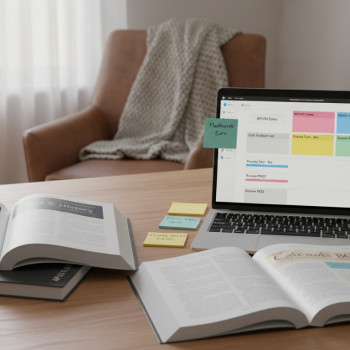Understanding the Power of Rubric Language
If you’ve ever stared at an AP free-response question and felt the scoring rubric was written in another language, you’re not alone. But here’s the good news: rubrics are not mysterious traps — they’re cheat codes. They tell you, in plain (if formal) terms, what exam readers are looking for. Once you learn to mirror that language in your answers, you stop guessing and start scoring.

Why Rubric Language Matters
Every AP free-response rubric is a roadmap. Each point on that rubric corresponds to a clear action or inclusion in your answer. When you mirror their phrasing — using the same verbs, addressing the same elements, and structuring your response to match the rubric’s expectations — you make the grader’s job easy. Graders read hundreds of responses; they look for the presence (or absence) of things. If you put what they want in the places they expect, you’ll earn points more consistently.
Three Simple Principles to Start Using Rubric Language Today
- Listen to the verbs: Words like “describe,” “explain,” “analyze,” and “compare” each demand a different level of thinking. Match your response to the verb.
- Address all parts: If a prompt has two or three subparts, explicitly label them or structure your answer so each part is clearly answered.
- Use the rubric’s terms: If the rubric rewards “evidence that supports X,” explicitly write that your “evidence supports X,” and show how. Mirror, don’t paraphrase to the point of drifting away.
Decoding Common Rubric Verbs (and What They Actually Want)
Rubric verbs are not decorative. They signal the depth and form your response should take. Below is a practical guide to the most common verbs and the kind of content that earns points for each.
| Rubric Verb | What the Reader Expects | How to Mirror It in Your Answer |
|---|---|---|
| Describe | Provide observable details or characteristics. | Start with a concise description: “This shows…” or “This resulted in…” |
| Explain | Show cause-and-effect or reasoning that links facts to an outcome. | Use phrases like “because,” “therefore,” or “this led to” and explicitly tie causes to effects. |
| Analyze | Break something into parts and show relationships or implications. | Signal structure: “First,” “Additionally,” and conclude with “This implies…” |
| Compare / Contrast | Highlight similarities and/or differences and explain their significance. | Use parallel structure: “Both…” and “However…” or “In contrast…” |
| Evaluate / Assess | Make a judgment supported by criteria and evidence. | State a clear judgment up front and defend it: “Therefore, X is more effective because…” |
Quick Example: Turning ‘Explain’ into Points
Prompt: “Explain how factor A influenced outcome B.” A weak answer might say “Factor A affected B.” That’s too vague. A rubric-mirroring answer would say: “Factor A influenced outcome B by [specific mechanism], because [evidence], therefore [consequence].” You’ll notice the scaffolding: mechanism, evidence, consequence — all verbs the rubric rewards.
Mirror Phrases That Often Appear in AP Rubrics
Many rubrics reward specific phrases or types of statements. You don’t have to copy them word-for-word, but reflecting their structure gives readers an immediate signal that you’re answering on target. Below are mirror phrases to practice. These are templates — fill them with content that fits the prompt.
- “Provides evidence that…” → Mirror: “The passage/data shows…, which supports…”
- “Identifies and explains…” → Mirror: “X is [identified], and this explains [reason/significance] because…”
- “Compares X and Y with reference to…” → Mirror: “Both X and Y share…, but they differ in…, which matters because…”
- “Analyzes the extent to which…” → Mirror: “To a great/limited extent, [claim] is true because…”
Practice Template
Try this structure when a rubric asks for evidence plus explanation:
- Claim/Answer (1 sentence): Directly respond to the prompt using its keywords.
- Evidence (1–2 sentences): Quote or paraphrase specific data/text and indicate it’s the evidence.
- Explanation (2–3 sentences): Connect the evidence to the claim using causal or analytical language matching the rubric verb.
- Conclusion (1 sentence): Re-state how the evidence fulfills the rubric requirement.
Concrete Examples Across AP Subjects
Rubric language works similarly across AP subjects, though specific content differs. Below are short, subject-specific examples showing how to mirror rubric language effectively.
AP English (Literature or Language)
Rubric likely asks: “Analyze how the author uses X to achieve Y.” Mirror it directly: “The author uses [device] to [effect] by [mechanism]. Evidence: [quote]. This shows… which advances the theme/argument by…” Use explicit evaluative words like “suggests,” “reveals,” and “reinforces.”
AP U.S. History
Rubrics often ask for cause-and-effect plus evidence. Example structure: “One significant cause of X was Y, because [evidence], which led to [consequence].” When the rubric asks for multiple causes or perspectives, label them (A, B) and mirror the wording: “One interpretation is… Another perspective is…”
AP Biology / Chemistry / Physics
In science FRQs, rubrics reward precise terminology, clear mechanism descriptions, and correct calculation setups. Mirror the rubric by naming variables, stating assumptions, and writing equations or steps that graders expect. If the rubric asks for “justify,” provide both the calculation and a one-sentence conceptual justification.
How to Practice Mirroring Rubrics (Study Plan)
Learning the language of rubrics is a skill you improve with deliberate practice. Here’s a study plan you can use over four weeks to internalize rubric language and make it second nature.
| Week | Focus | Daily Practice (30–60 min) |
|---|---|---|
| 1 | Familiarize | Read 2 scorers’ rubrics from past free-response questions; highlight verbs and mirror phrases. |
| 2 | Template Building | Create 3 answer templates (evidence/explain/analyze) and practice plugging in content. |
| 3 | Timed Practice | Complete 4 timed FRQs, explicitly labeling rubric match points in margins. |
| 4 | Feedback and Refinement | Review scored samples or get a tutor to assess rubric mirroring; iterate on phrasing. |
How Sparkl’s Personalized Tutoring Can Fit In
Practice is more effective when guided. If you use personalized tutoring, like Sparkl’s 1-on-1 guidance, you can have a tutor identify exactly where your answers miss rubric language and give tailored study plans to fix those gaps. Tutors can model mirror phrases in real time and give AI-driven insights into which rubric items you miss most often — speeding up your improvement with targeted feedback.
Example Walk-Through: Turning a Weak Answer into a Rubric-Mirror Answer
Let’s work through a mock AP-style prompt together. I’ll show a weak answer, then revise it to mirror rubric language and gain points.
Mock Prompt
“Explain how economic factor X contributed to political outcome Y. Provide two pieces of evidence and analyze the connection between them and the outcome.”
Weak Student Answer
“Economic factor X caused political outcome Y because people were unhappy. Evidence: unemployment rose and prices were high. Also, protests increased.”
Rubric-Mirror Revision
“Economic factor X contributed to political outcome Y primarily through its impact on household purchasing power and labor stability. Evidence 1: Unemployment rose from A% to B% between years M and N, reducing disposable income and increasing economic insecurity. Evidence 2: Inflation of C% during the same period eroded wages, worsening cost-of-living pressures. Together, reduced purchasing power and labor market instability heightened public dissatisfaction and mobilized opposition groups, which increased the political salience of demands for change and helped precipitate outcome Y. Thus, both empirical trends directly link X to Y by creating the social and economic conditions necessary for political upheaval.”
Why this improved answer works: it (a) directly mirrors the rubric’s demand for evidence plus analysis; (b) labels and provides two distinct pieces of evidence; (c) links each piece of evidence to the causal mechanism; and (d) concludes by tying the analysis back to the outcome. This structure aligns with typical rubric language and earns more points.
Common Pitfalls and How to Avoid Them
Even when you know rubric language, there are traps that can cost points. Here are the most common missteps and quick fixes.
- Vagueness: Avoid broad statements without specifics. Fix: add data, quote, or an exact example.
- Off-Topic Evidence: Don’t present interesting facts that don’t answer the prompt. Fix: always conclude the sentence with “which shows…” linking back to the prompt.
- Not Using the Prompt’s Language: If the prompt asks about “causal mechanisms,” don’t merely “describe events.” Fix: use causal verbs: “led to,” “therefore,” “resulting in.”
- Poor Organization: Random paragraphs lose points. Fix: use the claim–evidence–analysis template and label parts clearly if needed.
Self-Check List Before Submitting an FRQ
- Did I use a rubric verb in my first sentence (e.g., “Explain,” “Analyze”)?
- Did I include the number/type of evidence items the prompt asked for?
- Did I explicitly connect each piece of evidence to my claim?
- Is my language precise and consistent with the rubric’s terms?
- Is there a concluding sentence that ties the answer back to the prompt?
Turning Rubric-Mirroring Into an Exam-Day Routine
On exam day, stress and time pressure can make you forget good habits. Create a short, repeatable routine to prime rubric-mirroring every time you sit down to an FRQ.
3-Minute Pre-Write Ritual
- Read the prompt and underline the rubric verb(s) and required elements.
- Write a one-sentence thesis that uses the rubric verb and answers directly.
- List the pieces of evidence you will use (one line each) and the mechanism linking them to your thesis.
This short ritual aligns your brain with the rubric before you start writing and prevents wandering answers.
Advanced Tip: Mirror the Rubric Without Sounding Robotic
Some students worry that mirroring rubric language will make their writing sound formulaic. The trick is to use the rubric’s structure but natural, varied language. Here are some ways to do that:
- Swap in synonyms where appropriate but keep the action clear: e.g., instead of repeating “demonstrates” five times, alternate with “indicates,” “reveals,” or “underscores.”
- Vary sentence length: a crisp, rubric-aligned claim sentence followed by a richer explanatory sentence reads naturally and persuasively.
- Use context-specific transitions: “Because of X,” “As a result of Y,” and “Consequently” are all rubric-friendly but can be arranged to avoid monotony.
Real-World Context: Why This Skill Matters Beyond AP Tests
Mirroring rubric language isn’t just an exam hack. It’s a portable communication skill. In college essays, lab reports, policy memos, or job applications, people evaluate your work against criteria — and when you can read those criteria and meet them clearly, you stand out. Learning to frame your arguments to match the reader’s expectations is a professional advantage.
How Tutors and Tools Help You Generalize the Skill
One-on-one tutoring accelerates this skill transfer. Tutors can provide:
- Targeted drills that focus on the verbs you most often miss.
- Personalized feedback showing exact rubric items you didn’t meet and how to phrase them next time.
- Mock exams with real-time guidance to practice the pre-write ritual and reduce exam anxiety.
Sparkl’s personalized tutoring blends expert tutors and AI-driven insights to pinpoint recurring rubric misses and create a tailored study plan — a powerful combination for students who want structured growth without fluff.
Final Checklist: Mirror to Master the Rubric
Before we close, here’s a compact checklist you can print or memorize. Use it as your last glance before you hand in an FRQ:
- Does my opening sentence use the rubric verb and answer the prompt directly?
- Have I included the number and type of evidence items requested?
- Do I explicitly link evidence to claims using causal or analytical language?
- Have I labeled multi-part responses or clearly separated them so each part is addressed?
- Is there a concise conclusion tying all parts back to the prompt?
- Did I keep language precise and avoid irrelevant facts?
Parting Thought
Rubrics are not the enemy. They’re your ally. When you learn to read scorers’ language and mirror it in your responses, you convert uncertainty into strategy, randomness into points. Start small — one rubric verb at a time — and build templates that match what graders reward. With deliberate practice (and, when helpful, personalized tutoring to speed the feedback loop), you’ll find your free-response scores rising not because you got luckier, but because your answers finally speak the language graders use to award points.
Now take one past FRQ, underline the rubric verbs, and try the three-minute pre-write ritual. You might be surprised how much clearer your answer becomes — and how many more points you earn.
























No Comments
Leave a comment Cancel